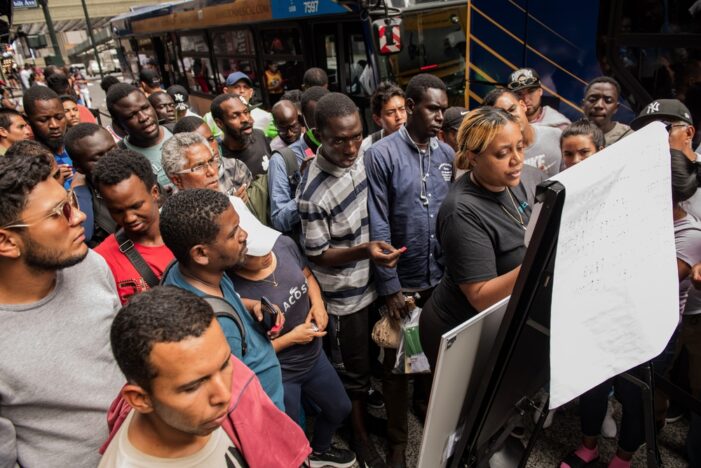Editorial credit: Roy De La Cruz / Shutterstock.com
By Arya Sundaram | December 15, 2023 | Gothamist
New York City’s budget watchdog estimates it will cost $6 billion to 7.8 billion to care for the city’s migrants over the next two years, up to $4.8 billion less than what the mayor’s office forecast in August.
The new Independent Budget Office’s estimates — far shy of the $10.8 billion, two-year tab forecast by the Mayor’s Office of Management and Budget just months ago — are predicated on the city’s providing for fewer migrants than projected by the mayor’s office, along with lower per-diem costs, according to the IBO.
The difference between the two estimates — as much as $4.8 billion, through the end of June 2025 — is greater than the annual fire and sanitation department budgets combined.
Mayor Eric Adams’ administration is in the midst of implementing new 30- and 60-day limits on shelter stays — intended to curb the growing shelter population and costs.
Though the administration says it accounted for the policy in their own spending estimates, IBO says more migrants departed the shelter system than the mayor’s office had previously predicted. Some 80% of migrants who have reached their stay limit have exited the shelter system, according to city hall data.
Some immigrant and housing advocates opposed to the stay limits have questioned whether they will actually reduce costs as displaced migrants unable to find housing on their own are permitted to reapply for shelter.
Savings on migrant spending, along with jobs left vacant, are key drivers of what the IBO projects as a $3.6 billion overall city surplus for the fiscal year that runs through June. The agency says that surplus will contribute to a smaller-than-expected budget gap next fiscal year, now projected at $1.8 billion.
The Adams administration has a much bleaker budget outlook, projecting a $7.1 billion shortfall.
Mayor Eric Adams has recited the budget gap and ballooning migrants costs — more than 65,000 migrants are in the city’s care — in calling for severe belt-tightening, including another 5% budget cut this fall to city agencies, with cuts to libraries, school staff, pre-K and composting, and a freeze on hiring new police officers.
But the IBO’s report bolsters claims from City Council members that the city’s economic future is more stable than the mayor has suggested. Speaker Adrienne Adams and Finance Chair Justin Brannan have argued there is room for flexibility to avert some cuts.
“The City is facing tough economic headwinds in the coming years that we must confront,” Speaker Adams said in an oversight hearing on Adams’ budget plan on Monday. “But our approach must be surgical and strategic, prioritizing the investments that we need to safeguard for New Yorkers.”
“Many factors are contributing to the gaps in our city’s out-year budgets, and asylum-seekers are not to blame,” she added.
City Hall spokesperson Charles Lutvak said the administration maintains that spending on migrants is one of multiple factors contributing to the city’s budget shortfall.
Jacques Jiha, the mayor’s budget director, said in a City Council hearing earlier this week that the city cannot rely on cuts to other agencies to help fund the influx of migrants. More state and federal help is needed, he said.
“It is not sustainable,” Jiha testified. “If we are not able to substantially reduce the migrant census, we face very difficult and grim decisions around how to fund this national humanitarian crisis.”
Even as the federal and state governments have provided New York City with more aid to house and process migrants, IBO Director Louisa Chafee said the two governments are still not sharing the costs of the migrant crisis as they have for other social services.
“The city is disproportionately carrying the share of asylum-seeker costs,” Chafee said.
With fewer asylum-seekers, the IBO also estimates that daily costs will drop to $320 per migrant household, down from $383, the figure the mayor’s office used to craft its fall financial plan.
The IBO’s predictions don’t factor in additional administrative costs from implementing the 30-day or 60-day limits, such as helping displaced migrants reapply for shelter, or to transport children to school, among other future scenarios.
“Reducing the [migrant shelter] population via exits is not a pure cost saver,” said IBO analyst Claire Salant. “There’s going to be other costs from that. So it’s a complicated way for them to try to reduce costs.”

